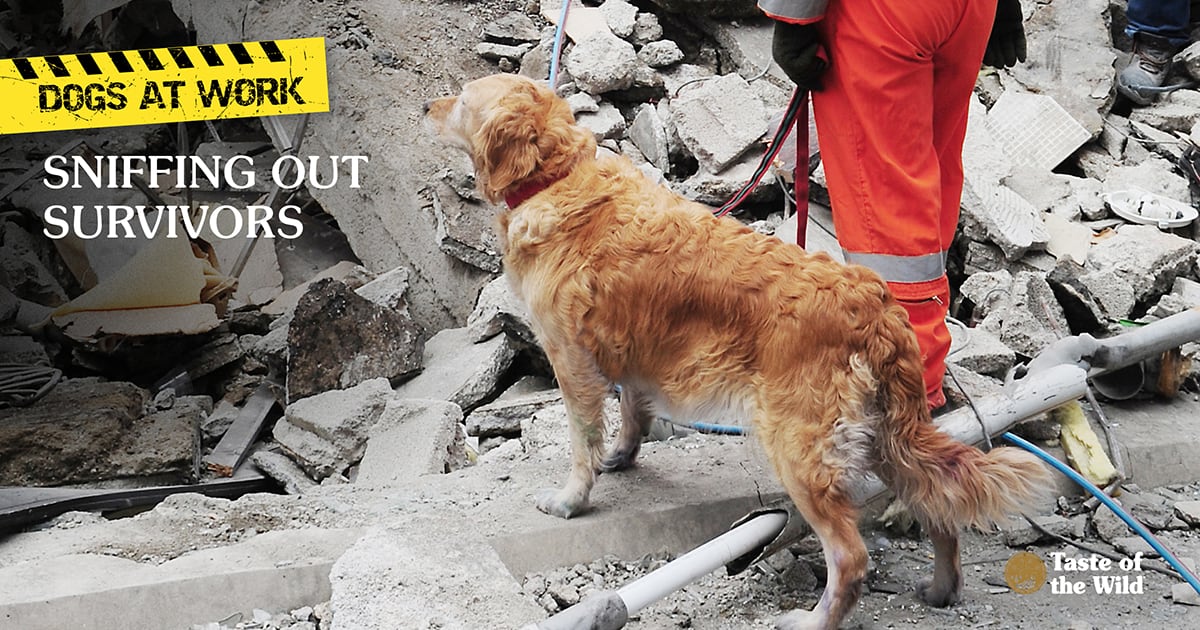
Every time a natural or not-so-natural disaster makes headlines, you can bet that urban search and rescue dogs (USAR) are quietly at work behind the scenes. From Ground Zero and Hurricane Katrina to tornadoes in Oklahoma, floods in Colorado, mudslides in Washington and even earthquakes in Haiti, these trained rescue dogs have applied their noses to locate survivors buried amid the wreckage and rubble.
In the service of humanity
Search and rescue canines are specifically trained to use air-scenting to locate live humans in the wilderness or urban areas. Others, known as cadaver dogs, specialize in finding human remains in the same environments (as well as in bodies of water). Some dogs are able to locate both, and are typically trained to give a different signal depending on whether the victim is alive or dead.
USAR dogs specialize in finding live humans in buildings and structures that have collapsed. They are typically owned and trained by certified volunteers, police officers or firefighters.
On-the-job hazards
As you can imagine, USAR dogs and their handlers often need to climb on unstable surfaces and pick their way through glass shards and sharp metal while possibly being exposed to toxic chemicals, fires or smoke. Despite the health risks and long hours on the job, injuries to these dogs are relatively rare. Mostly, they experience minor cuts and scrapes, with footpad injuries being most common. However, most dogs don’t wear protective gear because booties, collars and other gear may increase the dog’s risk of injury in tight spaces. Dehydration, fatigue and weight loss are common health concerns that come with this work.
Despite the wear and tear they see, USAR dogs suffer few long-term effects. When researchers followed almost 100 of the Ground Zero dogs for years after the incident, they found that the dogs typically went on to lead healthy lives. In fact, Bretagne, the last surviving Ground Zero USAR dog, worked Hurricanes Katrina and Rita before being laid to rest in 2016 at the age of 16.
The best canine candidates
Saint Bernards may have been one of the original breeds used for search and rescue work, but now other breeds are typically used. For example, Labrador retrievers excel at search and rescue work. Other common breeds trained for search and rescue work include German shepherds, Belgian Malinois, Chesapeake Bay retrievers, golden retrievers and border collies.
But when looking for USAR candidates, trainers and handlers looks for qualities beyond breed, such as a high “toy drive,” meaning dogs are enthusiastic and willing to overcome obstacles to chase, hunt and find hidden toys. Successful dogs must be able to focus on the search and not be distracted by sirens, loud machinery and crowds of people. It’s important for dogs to be obedient and non-aggressive to people and other animals. And of course, dogs need to be fairly agile and coordinated to climb through collapsed buildings.
Tough training
In 2012, the Penn Vet Working Dog Center was founded at the School of Veterinary Medicine at the University of Pennsylvania, in part to help train detection dogs.
The center has its own breeding program and accepts dogs donated from breeders. Puppies are generally screened to make sure they don’t have conditions such as elbow or hip dysplasia, which may make it difficult to perform their duties over a decade of service.
Daily training begins at eight weeks of age with both physical and behavioral exercises, and it can take up to two years for a dog to become certified. Puppies are exposed to a wide range of people, environments and noises at the same time they’re provided with positive reinforcement. When not in training, they live with foster families on nights and weekends to continue socialization.
Dogs are trained to play hide and seek, and rewarded when they find a hidden toy. Eventually, the dogs work their way up to finding hidden human “victims” in simulated rubble piles.
Because working detection dogs can be prone to hip and lower back problems, the center works with dog to develop core strength, balance and confidence in foot placement to help prevent injuries. Dogs are even taught how to climb ladders. And canine handlers keep tabs on pet nutrition, to help keep dogs lean and agile.
Even after FEMA certification, dogs must remain fit, current on training and ready for deployment at a moment’s notice. After all, it’s not just human lives that are at stake — these USAR dogs put their lives on the line every time duty calls.
The information in this blog has been developed with our veterinarian and is designed to help educate pet parents. If you have questions or concerns about your pet's health or nutrition, please talk with your veterinarian.
